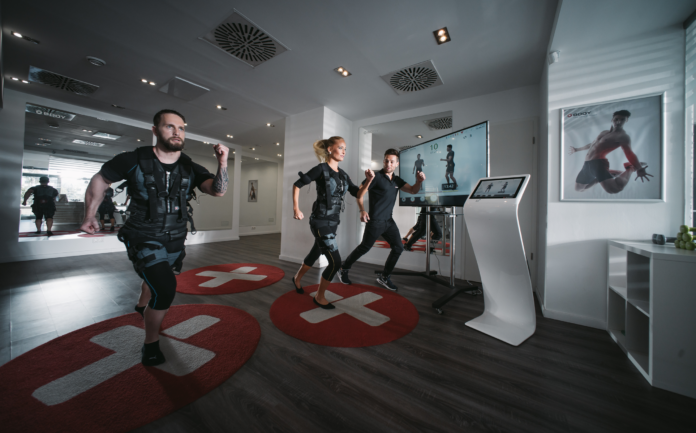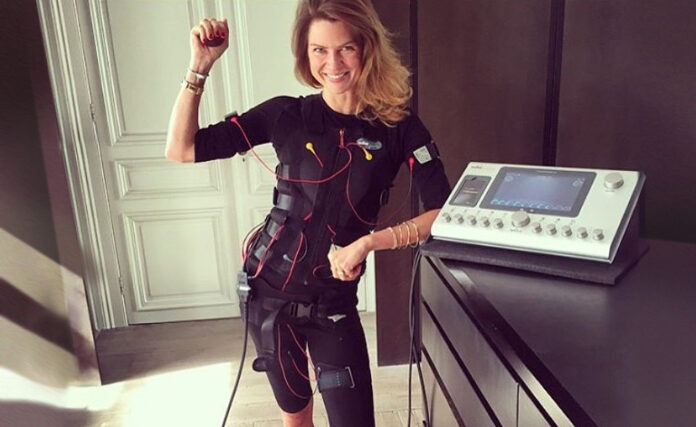Electric Muscle Stimulation training. This form of physical workout uses electrical impulses to cause your muscles to contract. Think of it as a workout for your muscles without needing to do traditional exercises like lifting weights or running.
A device sends electric signals to your muscles, mimicking the action your brain usually takes when telling muscles to move. People use EMS for various reasons like improving fitness, losing weight, and rehabilitating muscles.
The Science
Electric Muscle Stimulation relies on electric impulses. Normally, your brain sends a signal to your muscles through the nervous system when you want to make a movement. The EMS device does this externally.
You attach electrodes to your skin near the muscles you want to stimulate. The device then sends electric impulses that cause your muscles to contract and relax, similar to regular exercise. For more information check out: EMS training Dubai!
How It Works
To start, go to a specialized facility or gym. An instructor helps you put on a suit or attach electrodes to parts of your body. This suit connects to the EMS device. Once you’re ready, the device sends out electric signals, causing your muscles to contract.
Often, you’ll perform basic exercises like squats or lunges while the device is on, making your muscles work harder than they would without stimulation.
Potential Benefits
EMS training offers several benefits:
- Time-saving: Because EMS can engage multiple muscle groups at once, you can have a shorter workout.
- Effective for rehabilitation: Doctors often recommend EMS for patients recovering from injuries.
- Versatile: You can target specific muscle groups that are hard to reach with conventional exercise.
- Can complement other training: Many athletes use EMS as an addition to their regular workout routine.
Risks and Precautions
While generally safe, there are some risks. Some people might experience skin irritation from the electrodes. It’s also important to avoid overuse, as this can lead to muscle strain.
People with certain medical conditions, like heart problems or epilepsy, should however avoid the practice. Always consult with a healthcare provider before starting a new exercise program.
How to Choose a Provider

Look for places that have certified trainers experienced in EMS. Make sure the facility follows safety guidelines and keeps equipment clean. Also, consider the cost, as EMS training can be more expensive than a regular gym membership.
Who Can Benefit?
Anyone interested in enhancing their physical fitness might find EMS useful. Athletes often use it to improve performance, targeting specific muscles related to their sport.
Busy individuals who can’t spend hours in the gym may appreciate the time-saving aspect.
EMS is also useful for people who need a low-impact exercise option, including the elderly or those with certain types of injuries.
However, it’s essential to consult a medical professional before beginning any new fitness regimen, especially for those with existing health conditions.
Is it a Replacement for Conventional Workouts?
The answer is both yes and no. EMS training can provide a robust workout in a shorter amount of time, and you’ll certainly feel it the next day.
However, conventional exercise like running, swimming, or weight lifting offers benefits that EMS can’t fully replicate, such as improving cardiovascular health or enhancing skill-based coordination.
Therefore, many people find the most benefit from a balanced approach that includes both EMS and traditional exercise methods.
How Often Should You Undergo It?

The frequency of EMS training sessions will depend on your personal goals and physical condition. For general fitness, once or twice a week can provide noticeable results.
If you’re an athlete looking to enhance specific muscle groups or improve performance, more frequent sessions may be necessary.
However, overdoing it could result in muscle strain or injury. Just like any other form of exercise, it’s crucial to allow time for recovery between sessions. Consulting a certified EMS trainer or a healthcare provider can help you determine an appropriate schedule.
Is it Cost-Effective?
EMS training can be more expensive than a traditional gym membership, and costs can vary widely depending on the facility and the frequency of sessions. However, many people find that the time-saving aspect and targeted muscle engagement make it worth the investment.
Some providers offer package deals for multiple sessions, which can make it more affordable. Before committing, it might be worthwhile to try a single session or take advantage of any trial offers to make sure it’s a good fit for you.
How to Get Started
If you’ve decided that EMS training is something you want to try, the first step is to find a suitable facility or provider. Look for certified EMS trainers with good reviews and a track record of following safety guidelines.
Your initial session will likely include a consultation to discuss your fitness goals and any medical conditions you might have.
During this consultation, make sure to ask any questions you have about the process, including what you should wear, what you can expect during the session, and any after-care recommendations.
Monitoring Your Progress

Tracking your progress is important in any fitness regimen, and EMS training is no exception. Many EMS providers offer assessments at various intervals to see how you’re doing.
These might include measurements of muscle mass, body fat percentage, or tests of physical strength and endurance.
If your goal is weight loss, muscle gain, or improvement in some specific area, these assessments can help tailor your EMS sessions to be more effective. Keep open communication with your trainer to ensure that your training aligns well with your goals.
Common Myth
As with any new technology or approach to health and fitness, there are a number of myths and misconceptions. One common myth is that it’s a “lazy” way to exercise, which is far from the truth. While EMS can make your workout more efficient, it still requires effort and engagement on your part.
Another myth is that EMS training is painful. While you’ll definitely feel your muscles working, and you might experience some soreness afterwards, the process itself shouldn’t be painful. If it is, that’s a sign that the settings are too high or that EMS may not be appropriate for you.
Conclusion
EMS training offers a unique approach to physical fitness, using electrical impulses to stimulate muscle contractions. It’s a versatile option that can benefit a range of individuals, from busy professionals to athletes to those needing low-impact options.
However, like any exercise program, it’s essential to take proper precautions and consult with healthcare providers and certified trainers.
With the right approach, EMS training can be an effective, time-saving, and rewarding way to improve your physical fitness.







